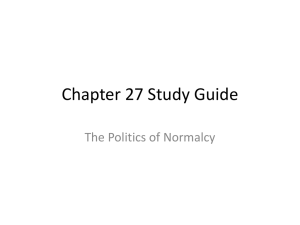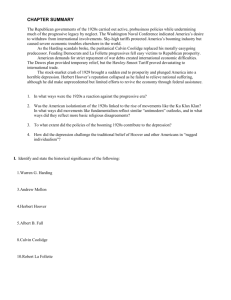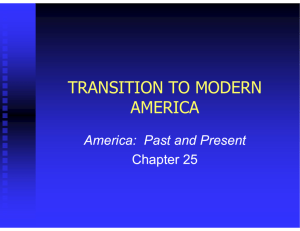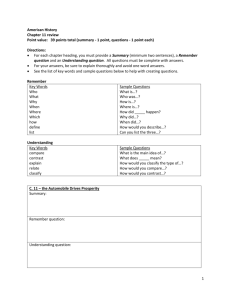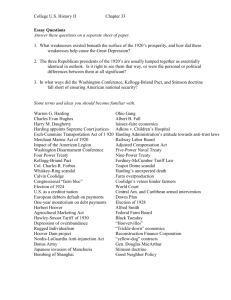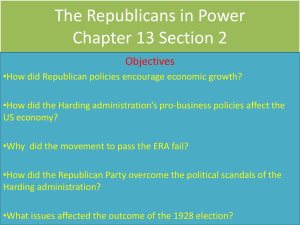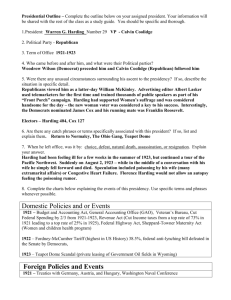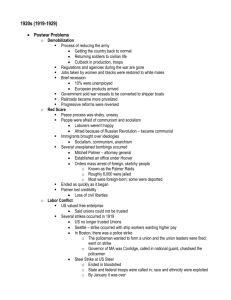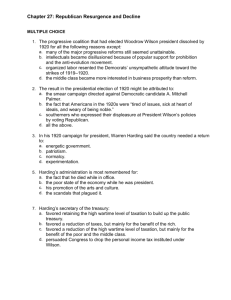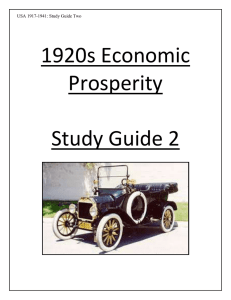1920s Politics: Boom and Bust - Harding, Coolidge, Hoover
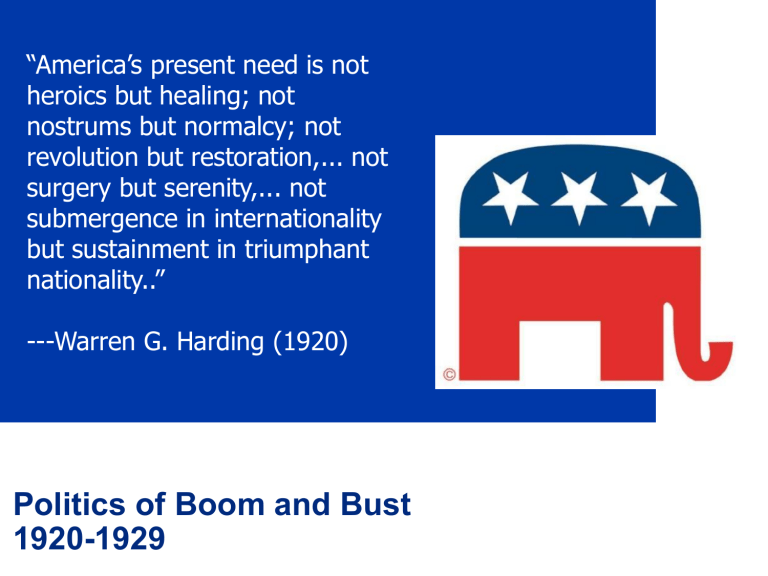
“America’s present need is not heroics but healing; not nostrums but normalcy; not revolution but restoration,... not surgery but serenity,... not submergence in internationality but sustainment in triumphant nationality..”
---Warren G. Harding (1920)
Politics of Boom and Bust
1920-1929
2
Three Republican Presidents
–Warren G. Harding
–Calvin Coolidge
–Herbert Hoover
• All retreated from progressive reforms
• All wanted to help public through
•
•
LESS Government action
MORE cooperation with big business.
Politics and Prosperity 1920-1929
A Republican Decade: Warren Harding (1921-1923)
Foreign Policy-
Isolationism (no entangling alliances)
-
Fordney-McCumber Tariff (1922)- Historically high tariff passed to protect American industries. Creates cycle of debt between Europe and USA
-
Disarmament- Washington Conference (1921-
1922). Reduce large navies to prevent war. Focus on battleships not cruisers, destroyers or submarines. Gives
Japanese military superiority in the Pacific.
3
Politics and Prosperity 1920-1929
A Republican Decade: Warren Harding (1921-1923)
Domestic Policy-
Emergency Quota
Act (1921). 1920-1921– 800,000 immigrants came to America, mainly from southern and eastern Europe.
-Restricted immigrants to 3% of their nationality in the US according to the
1910 (shuts off immigration from southern and eastern Europe)
4
Politics and Prosperity 1920-1929
A Republican Decade: Warren Harding (1921-1923)
Scandal and Corruption-
-Ohio Gang- Group of scandalous politicians and industry leaders associated with the Harding Administration
-Teapot Dome- Albert Fall (Sec of Interior) gave away oil-drilling rights on government land in return for
$300,000 in cash and gifts.
5
Coolidge (1923-1929)
A Republican Decade: Calvin Coolidge
(1923-1929)
• “Silent Cal”
• Not touched by the
Harding scandals
• Bright figure of the
Republican party
• Traditional, old-timey, and boring.
6
Politics and Prosperity 1920-1929
Bypassed by the Boom: Farmers
Wartime Prosperity-
Europe could not produce goods so US farmers became main suppliers. US government encouraged farmers to plant fence post to fence post.
7
Machines-
Allowed farmers to produce more. Increased efficiency and huge surpluses (Europe was back).. 1920s 1 in 4 farms sold for taxes or debts.
Relief-
Capper-Volstead Act-Exempted farmers’ marketing cooperatives from antitrust prosecuting.
McNary-Haugen bill (government would buy surplus and sell abroad). Vetoed by
President Coolidge. Farm prices stayed low.
Welcome to the Great Depression.
8
Election of 1924 – 3 Way Race
• Coolidge Republican
• nominee
Won 382 Electoral
• John Davis Democratic
• nominee
Won 162 Electoral
• Robert La Follette
Progressive Party
• nominee
Won 13 Electoral
Politics and Prosperity 1920-1929
A Republican Decade: Calvin Coolidge (1923-1929)
Domestic Policy-
Brought back faith in federal government (helped significantly by the economic boom of the 1920s).
Laissez Faire-
Business of America is business. Government stays out of big business.
1924 immigration act
- Replaces the 1921 Quota Act.
-Quota to 2% and shifted to 1890 census
-Japanese were banned
-Canadian and Latin American immigrants were exempted. They could be used as temporary labor source
9
Politics and Prosperity 1920-1929
A Republican Decade: Calvin Coolidge (1923-1929)
Foreign Policy-
Continued Harding’s foreign policy of isolationism
Dawes Plan-
Allies unable to repay war debts.
Allies force Germans to make reparations.
1. U.S. banks loaned money to Germany
2. Germany paid reparations to France and Britain
3. France and Britain paid war debts to the U.S.
Results-
Helps the Great Depression go global.
The US is never fully repaid by the Allied Powers
10
Politics and Prosperity 1920-1929
The Mass-Consumption Economy
11
Consumer Economy-
New methods of production lower prices so more consumers can buy goods. New industries (electricity, chemicals, cars, radios) help raise standard of living. Mass production requires mass consumption. This becomes a problem by the end of the 1920s.
Advertising-
Advertisers sought to make
Americans want to buy more
Buying on Credit-
People bought on credit more and more during 1920s. Allowed
Americans to have refrigerators, vacuum cleaners, cars, and radios. Buying on credit threatened the health of the economy. (very similar to right now!).
12
Election of 1928
• Calvin Coolidge gives his
• paper to the press
“I do not choose to run”
• Republicans choose Herbert
Hoover.
• Democrats choose Alfred Smith
•
•
Nickname “Alcohol” Smith
He’s a Roman Catholic
• Radio became important during this election
• Hoover won by a landslide
13
Herbert Hoover 1929- 1933
• June 1929 - Agriculture
•
Marketing Act
Set up Federal Farm Board
• Revolving fund of $ ½ billion
• Hawley-Smoot Tariff of
•
•
1930
Raised the tariff to 60%!
Plunged Americans deeper into the Depression
14
The Great Crash- October 29, 1929
• Hoover predicted an end to poverty
• Causes of the Crash:
•
•
•
Brits raised their interests rates in an effort to bring back capital lured abroad by American investments.
After this people began to sell!
Over-speculation
Overly high stock prices built only upon nonexisting credit
• Results:
–End of 1930 – 4 million jobless Americans.
–Over 5,000 banks collapsed- first 3 years
–Lines at soup kitchens and homeless shelters
15
Possible Causes of the Great Depression
• Overabundance of farm products & factory products
• Productions outran consumption OR capacity to pay for goods.
• Over-expansion of credit = unsound faith in money
• 1930 Drought in Mississippi Valley
• Thousands of farmers had to sell farms to pay off debt.
• Dying of international trade – Hawley- Smoot
Tariff
16
Hoover gets the blame
• Critics said he could feed millions in
Belgium (after WWI) but not at home!
• He had the laissez-faire mindset and felt the depression would naturally pass.
• Finally, he withdrew $2.25 billion to start projects to alleviate suffering of depression
• 1932 Reconstruction Finance Corporation
(RFC) - Gov. lending bank
